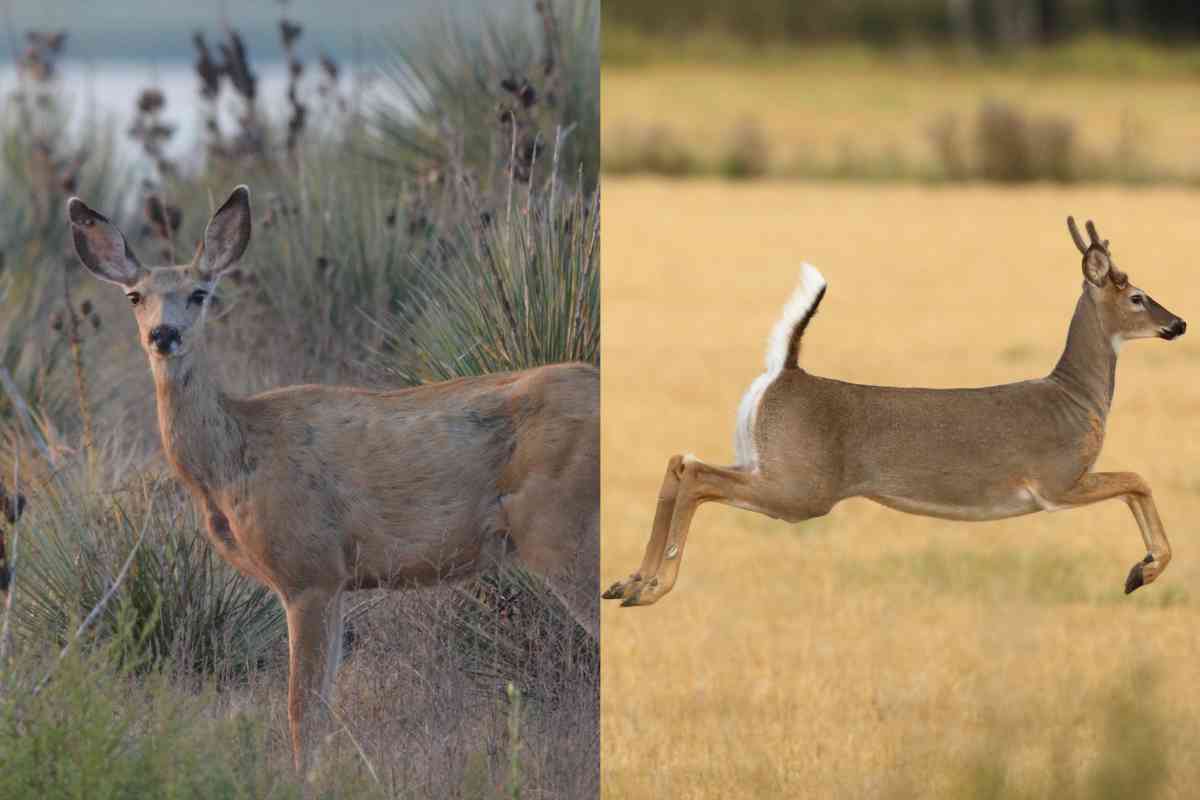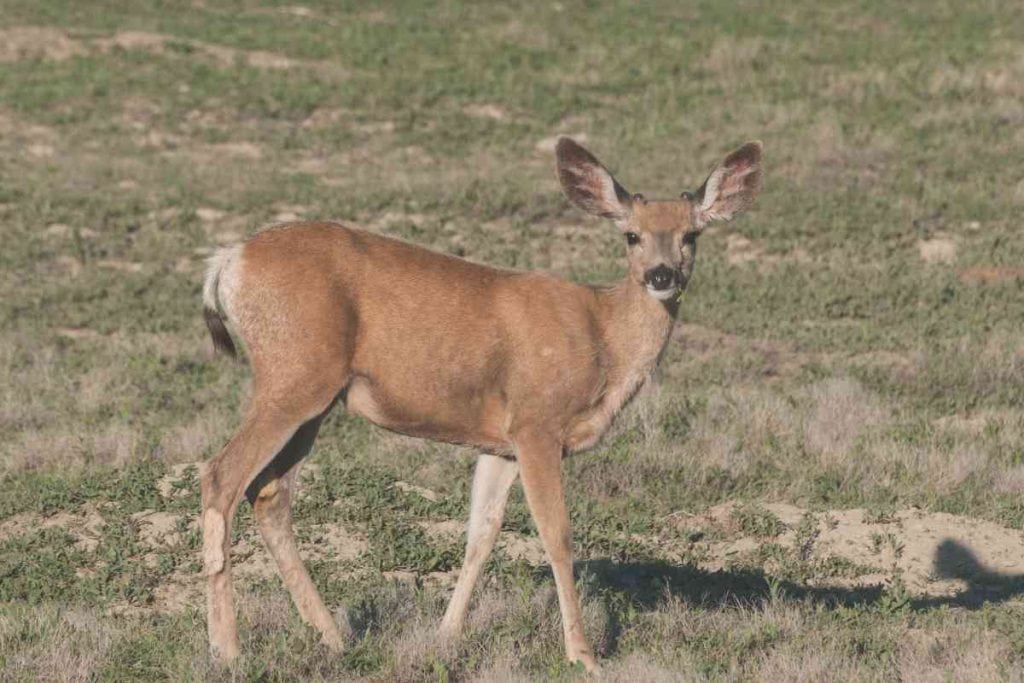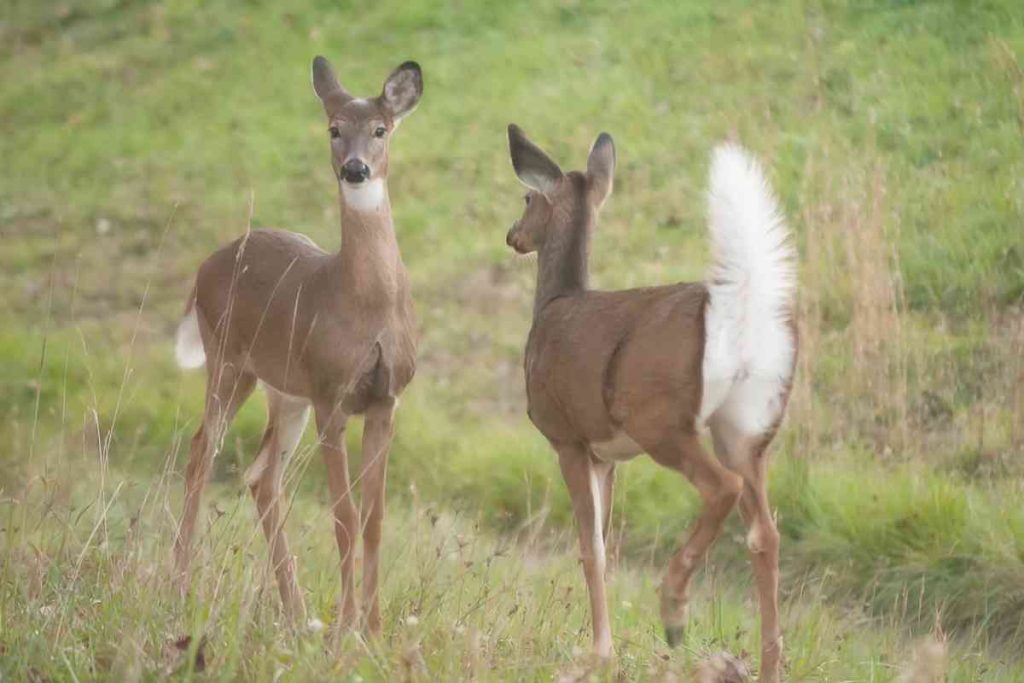Bowhunting is a popular activity that requires a great deal of skill and knowledge. To hunt ethically and lawfully, bowhunters must identify their target species correctly.
Mule deer and white-tailed deer are two common species in North America that bowhunters seek after.
Understanding the differences in appearance, behavior, and habitat between these two species can make a bow hunter more effective and versatile.
White-tailed deer are known for their adaptability and abundance. In contrast, mule deer are more migratory and prefer open, mountainous terrain.
Contents (Jump to Topic)
ToggleDifferences in Appearance and Behavior
Understanding the differences in appearance and behavior between mule deer and whitetails is crucial for ethical and lawful bowhunting, as mule deer and whitetails have distinct characteristics.
Mule deer are larger and have bigger ears, a face leading to a darker forehead, smaller tails with shades of tan and a black tip, and antlers with short brow tines or none.
On the other hand, whitetails have longer tails that are bright white on the undersides and antlers that typically grow a main beam with single points coming off of it and prominent brow tines.
read.. how to identify deer droppings
In terms of behavior, whitetails are more elusive and tend to spook easily, which makes them more challenging to hunt.
Mule deer tend to remain calm and may run only a short distance when startled, but they often pause to look back after doing so.
Whitetails are often hunted from a treestand or ground blind, while mule deer are hunted spot-and-stalk style in open areas.
Understanding these unique differences in the behavior and habitats of each species will make a bowhunter more versatile and effective.
Population and Habitat
The continental United States is home to over 20 million of North America’s most popular big game hunting: the white-tail deer.
Whitetails are found in nearly every state, and their adaptability allows them to inhabit various environments. They require food, water, and thick cover to hide from predators.
As you move further north, you may notice an increase in body size among deer. For instance, in Texas, a big buck typically weighs around 180 lbs, whereas a large buck from northern Minnesota can weigh up to 300 lbs.
The average weight for these animals is likely to be around 130 lbs and 200 lbs, respectively.
Their tails are long and bright white on the undersides, and they gallop with their white flags raised. “Whitetail antlers typically grow a main beam with single points coming off of it and prominent brow tines.”
Mule deer, on the other hand, have a range stretching from the easternmost part of Alaska down through Baja, Mexico.
They tend to prefer open, mountainous terrain and are found exclusively in the western half of North America.
Migratory in nature, mule deer spend “summer in higher elevations before migrating to lower elevations for winter,” with migration routes covering over 100 miles.
Mule deer bucks average around 150 pounds. Deer weight can vary due to specific times of the year and environmental factors.
Their tails are smaller, with shades of tan and a black tip, and they bound with a hopping-type movement called stotting.
“Mule deer antlers frequently have short brow tines or none at all, and the first tines off the main beam typically fork into two points.”
Source: https://bowhuntersunited.com/2022/12/27/mule-deer-versus-white-tailed-deer/
Understanding these differences in population and habitat is crucial for ethical and successful bowhunting.
Bowhunting Tactics
One popular tactic for bowhunting deer involves using trail cameras to scout and pattern their movements, especially for species with smaller home ranges.
Whitetail deer, for example, have relatively small home ranges and tend to stick to specific areas. Bowhunters can use trail cameras to identify travel patterns, feeding areas, and bedding sites.
This information can be used to pick the best location for setting up a tree stand or ground blind.
Additionally, trail cameras can help bowhunters determine the size and age of the deer in the area, which can help them make an informed decision about which animal to target.
In contrast, mule deer have larger home ranges and are more likely to move around for food and water.
This makes it more challenging to pattern their movements using trail cameras. Instead, bowhunters often spend hours glassing for mule deer from a distance. This involves using binoculars or a spotting scope to scan the landscape for deer.
Once a mule deer has been spotted, bowhunters can plan a stalk using landmarks and other features to guide them.
It’s important to move slowly and quietly and to keep the wind in your favor to avoid alerting the deer.
Waiting for the deer to stand before making a shot is essential to ensure a quick and ethical kill.
Importance of Proper Identification
Proper identification of deer species is crucial for successful and legal bowhunting practices. Bowhunters must be able to distinguish between mule deer and whitetails, as the hunting laws and regulations for these two species can vary depending on the state or province.
Only one species may be legally hunted in some areas, and identifying the target species correctly can lead to serious legal consequences and ethical concerns.
Bowhunters must learn to recognize the physical characteristics and behavior patterns that distinguish mule deer from whitetails to identify the target species correctly.
Mule deer have larger ears, a white face leading to a darker forehead, smaller tails with shades of tan and a black tip, and antlers with short brow tines or none.
On the other hand, whitetails have longer tails that are bright white on the undersides. These antlers typically grow a main beam with single points coming off it and prominent brow tines and gallop with their white flags raised.
Understanding these unique differences is essential for bowhunters to make informed decisions and target suitable species for ethical and lawful hunting practices.
Versatility in Bowhunting
Versatility in bowhunting requires an understanding of the unique differences in behavior and habitat between various big game species, allowing bowhunters to adapt their tactics and increase their chances of success.
For example, knowing the differences in their preferred environments and tendencies can significantly impact the hunt’s success when pursuing mule deer versus whitetails.
While whitetails are adaptable and can be found in various environments, mule deer prefer open, mountainous terrain and are often migratory.
Different hunting tactics may be necessary, such as spot-and-stalk for mule deer and hunting from a treestand or ground blind for whitetails.
In addition to understanding the differences in behavior and habitat, bowhunters must correctly identify their target species to hunt ethically and legally.
In states where mule deer and whitetails are present, such as Colorado and Wyoming, it is important to distinguish between the two species in the field.
By knowing the unique characteristics of each species, bowhunters can make informed decisions about which species to pursue and how to approach the hunt.
Overall, versatility in bowhunting requires a deep understanding of the nuances of each species, allowing bowhunters to adapt their strategies and increase their chances of success.








